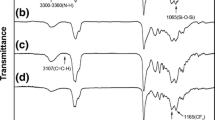Abstract
An epoxy resin was used to prepare crosslinked polyurethane hybrid emulsion through the blocked NCO prepolymer mixing process. Due to their hydrophobicity, the amine chain extender, blocked –NCO, and epoxy are located inside the emulsion particles. Thus, the crosslinking reaction occurs mostly in the interior of the particles. In this way, the crosslinking density of the resin is increased without the use of solidifying agents or heating during film formation, and the stability of the emulsions remains uninfluenced. The effects of the type of amine chain extender and the type, dosage, and addition mode of the epoxy resin were studied in terms of mechanical properties and swelling properties in water and toluene of the cast films. Additionally, the stability of the single-pack hybrid emulsion was studied. The results showed that the sample prepared with diethylene triamine had good stability, chemical resistance, and high mechanical strength. The modulus and water resistance of the films increased with the epoxy resin content, which could reach 20 wt%. The type of amine chain extender affected the stability of the emulsions significantly. The molar ratio of NH/NCO at 1:1 led to the best film performance. The optimal temperature of the chain-extension reaction was approximately 80°C. The hybrid emulsions could be stored for at least 6 months without apparent performance changes.










Similar content being viewed by others
References
Hsu, SL, Xiao, HX, Szmant, H, Frisch, KC, "Polyurethane Ionomers. 1. Structure Properties Relationships of Polyurethane Ionomers." J. Appl. Polym. Sci., 29 (8) 2467–2479 (1984). doi:10.1002/app.1984.070290804
Coogan, RG, Boghossian, RV, “Aqueous Dispersions of Polyurethane.” U.S. Patent 5,169,895, 1992
Coogan, RG, Boghossian, RV, “Aqueous Dispersions of a Nonionic, Water Dispersible Polyurethane Having Pendent Polyoxyethylene Chains.” U.S. Patent 5,043,381, 1991
Coogan, RG, "Post-crosslinking of Water-borne Urethanes." Prog. Org. Coat., 32 (1–4) 51–63 (1997)
Frisch, KC, Suthar, BP, Xiao, HX, “Anionic Waterborne Polyurethane Dispersion.” U.S. Patent 5,672,653, 1997
Orr, RB, Chicosky, L, Jr, “Method of Frothing Aqueous Ionic Polyurethane Dispersions and Products Produced Therefrom.” U.S. Patent 4,690,953, 1987
Wickert, FA, “Ambient Cure Protective Coatings for Plastic Substrates.” U.S. Patent 5,066,705, 1991
Blank, WJ, Tramontano, VJ, "Properties of Crosslinked Polyurethane Dispersions." Prog. Org. Coat., 27 (1–4) 1–15 (1996)
Hirose, M, Zhou, J, Nagai, K, "The Structure and Properties of Acrylic-Polyurethane Hybrid Emulsions." Prog. Org. Coat., 38 (1) 27–34 (2000). doi:10.1016/S0300-9440(99)00081-8
Sperling, LH (1997) Polymeric Multicomponent Materials. Wiley, New York
Adler, HJ, Jahny, K, Vogt-Birnbrich, B, "Polyurethane Macromers—New Building Blocks for Acrylic Hybrid Emulsions with Outstanding Performance." Prog. Org. Coat., 43 (4) 251–257 (2001). doi:10.1016/S0300-9440(01)00207-7
Huang, X, Ren, T, Tang, X, "Porous Polyurethane/Acrylate Polymer Electrolytes Prepared by Emulsion Polymerization." Mater. Lett., 57 (26–27) 4182–4186 (2003)
Park, MS, Cho, YH, Kim, BK, Jang, JS, "Fabrication of Reflective Holographic Gratings with Polyurethane Acrylate (PUA)." Curr. Appl. Phys., 2 (3) 249–252 (2002). doi:10.1016/S1567-1739(02)00101-3
Du, H, Zhao, Y, Yin, N, Li, Q, Wang, J, Kang, M, Xiang, H, Wang, X, "Preparation and Properties of Waterborne Polyurethane Adhesives Modified by Polystyrene." J. Appl. Polym. Sci., 110 (5) 3156–3161 (2008). doi:10.1002/app.28848
Zhao, C-X, Zhang, W-D, "Preparation of Waterborne Polyurethane Nanocomposites: Polymerization from Functionalized Hydroxyapatite." Eur. Polym. J., 44 (7) 1988–1995 (2008). doi:10.1016/j.eurpolymj.2008.04.029
Kim, BK, Lee, JC, "Modification of Waterborne Polyurethanes by Acrylate Incorporations." J. Appl. Polym. Sci., 58 (7) 1117–1124 (1995). doi:10.1002/app.1995.070580705
Dong, A, An, Y, Feng, S, Sun, D, "Preparation and Morphology Studies of Core-Shell Type Waterborne Polyacrylate–Polyurethane Microspheres." J. Colloid Interface Sci., 214 (1) 118–122 (1999). doi:10.1006/jcis.1999.5847
Chen, GN, Chen, KN, "Dual-Curing of Anionic Aqueous-Based Polyurethanes at Ambient Temperature." J. Appl. Polym. Sci., 67 (9) 1661–1671 (1998). doi:10.1002/(SICI)1097-4628(19980228)67:9<1661::AID-APP18>3.0.CO;2-X
Chen, GN, Chen, KN, "Hybridization of Aqueous-Based Polyurethane with Glycidyl Methacrylate Copolymer." J. Appl. Polym. Sci., 71 (6) 903–913 (2001). doi:10.1002/(SICI)1097-4628(19990207)71:6<903::AID-APP6>3.0.CO;2-O
Lee, ES, Kim, BK, "Modification of Aqueous Polyurethanes via Latex AB Crosslinked Polymers." J. Appl. Polym. Sci., 82 (6) 1315–1322 (2001). doi:10.1002/app.1966
Qu, J-q, Chen, H-q, "Synthesis and Properties of Waterborne Polyurethane Coating Modified by Epoxy Resin." J. Chem. Eng. Chin. Univ., 16 (5) 570–574 (2002)
Randhir, P, Kalpesh, P, Jayant, P, "High-Performance Waterborne Coatings Based on Epoxy-Acrylic-Graft-Copolymer-Modified Polyurethane Dispersions." Polym. Int., 54 (2) 488–494 (2005). doi:10.1002/pi.1712
Shi, YC, Wu, YS, Zhu, ZQ, "Modification of Aqueous Acrylic–Polyurethane via Epoxy Resin Postcrosslinking." J. Appl. Polym. Sci., 88 (2) 470–475 (2003). doi:10.1002/app.11750
Jang, JY, Jhon, YK, Cheong, IW, Kim, JH, "Effect of Process Variables on Molecular Weight and Mechanical Properties of Water-Based Polyurethane Dispersion." Colloid Surf. A, 196 (2–3) 135–143 (2002)
Jhon, JY, Cheong, IW, Kim, JH, "Chain Extension Study of Aqueous Polyurethane Dispersions." Colloid Surf. A, 179 (1) 71–78 (2001). doi:10.1016/S0927-7757(00)00714-7
Kultys, A, Rogulska, M, Pikus, S, "The Synthesis and Characterization of New Thermoplastic Poly(thiourethane-urethane)s." J. Polym. Sci. A, 46 (5) 1770–1782 (2008). doi:10.1002/pola.22520
Wu, G, Gu, J, Zhao, X, "Preparation and Dynamic Mechanical Properties of Polyurethane-Modified Epoxy Composites Filled with Functionalized Fly Ash Particulates." J. Appl. Polym. Sci., 105 (3) 1118–1126 (2007). doi:10.1002/app.26146
Ahmad, I, Zaidi, JH, Hussain, R, Munir, A, "Synthesis, Characterization and Thermal Dissociation of 2-Butoxyethanol-Blocked Diisocyanates and Their Use in the Synthesis of Isocyanate-Terminated Prepolymers." Polym. Int., 56 (12) 1521–1529 (2007). doi:10.1002/pi.2295
Ohtsuka, K, Hasegawa, K, Fukuda, A, "Synthesis and Curing Behavior of Urethane-Modified Epoxy-Resin Having Hydroxymethyl Group." Polym. Int., 31 (1) 25–34 (1993). doi:10.1002/pi.4990310105
Chen, C-H, Chen, M-H, "Synthesis, Thermal Properties, and Morphology of Blocked Polyurethane/Epoxy Full-Interpenetrating Polymer Network." J. Appl. Polym. Sci., 100 (1) 323–328 (2006). doi:10.1002/app.23195
Wicks, ZW, "New Developments in the Field of Blocked Isocyanates." Prog. Org. Coat., 9 (1) 3–28 (1981)
Liu, Y, Zhao, H, Li, G (2003) Isocyanates. Chemistry Industry Publishing Company of China, Beijing
Author information
Authors and Affiliations
Corresponding author
Rights and permissions
About this article
Cite this article
Wen, X., Mi, R., Huang, Y. et al. Crosslinked polyurethane–epoxy hybrid emulsion with core–shell structure. J Coat Technol Res 7, 373–381 (2010). https://doi.org/10.1007/s11998-009-9196-y
Published:
Issue Date:
DOI: https://doi.org/10.1007/s11998-009-9196-y




